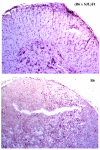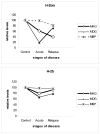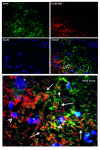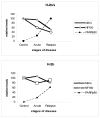Autoimmune-induced preferential depletion of myelin-associated glycoprotein (MAG) is genetically regulated in relapsing EAE (B6 x SJL) F1 mice
- PMID: 18541027
- PMCID: PMC2459167
- DOI: 10.1186/1750-1326-3-7
Autoimmune-induced preferential depletion of myelin-associated glycoprotein (MAG) is genetically regulated in relapsing EAE (B6 x SJL) F1 mice
Abstract
Background: Experimental autoimmune encephalomyelitis (EAE) is commonly used to investigate mechanisms of autoimmune-mediated damage to oligodendrocytes, myelin, and axons in multiple sclerosis (MS). Four distinct autoimmune mechanisms with subsequently distinct patterns of demyelination have been recognized in acute MS lesions. EAE correlates for those distinct patterns of MS lesions are unknown. An excessive loss of myelin-associated glycoprotein (MAG), as a result of distal oligodendrogliopathy, is found exclusively in the subtype III lesion. We sought to answer if types of demyelination in acute lesions during onset and relapse of EAE can replicate the specific patterns observed in MS acute lesions.
Methods: In parental H-2b (C57BL/6, B6) and hybrid H-2b/s [(B6 x SJL) F1] EAE mice, we examined spinal cord levels of MOG, MAG, and myelin basic protein (MBP), and compared to levels of axonal neurofilament (NF160) to assess axonal function, and levels of PARPp85 as an indicator of irreversible apoptosis.
Results: During disease onset, levels of MOG significantly dropped in both strains, although more profoundly in H-2b/s mice. Levels of MOG recovered in relapsing mice of both strains. Regulation of MAG was dissimilar to MOG. Modest loss of MAG was found at disease onset in both strains of mice. Unexpectedly, in relapsing H-2b/s mice, a major depletion of MAG and NF160, accompanied with sharp elevation of PARPp85 levels, was measured. PARPp85 immunoreactivity was observed in cytoplasm and nuclei of some MBP containing cells.
Conclusion: Taken together, our results show genetically controlled distinct patterns of MOG and MAG depletion, in MOG35-55 induced EAE in H-2b and H-2b/s mice. The data also suggest distinctive immune regulation of acute lesions that develop in relapsing compared to disease onset. A profound depletion of MAG, concomitant with marked depletion of axonal NF160, and sharp elevation of PARPp85 levels, occurred exclusively in relapsing H-2b/s mice. Our findings suggest concurrence of sharp decrease of MAG levels, axonal dysfunction and irreversible apoptosis with severe relapsing disease in H-2b/s mice. We propose that MOG-induced EAE in H-2b/s mice may prove as a useful model in studying mechanisms, which govern autoimmune-induced preferential loss of MAG, and its impact on oligodendroglial pathology.
Figures









Similar articles
-
Time-Dependent Progression of Demyelination and Axonal Pathology in MP4-Induced Experimental Autoimmune Encephalomyelitis.PLoS One. 2015 Dec 11;10(12):e0144847. doi: 10.1371/journal.pone.0144847. eCollection 2015. PLoS One. 2015. PMID: 26658811 Free PMC article.
-
Anti-IL-16 therapy reduces CD4+ T-cell infiltration and improves paralysis and histopathology of relapsing EAE.J Neurosci Res. 2005 Mar 1;79(5):680-93. doi: 10.1002/jnr.20377. J Neurosci Res. 2005. PMID: 15682385
-
T cell and antibody responses in remitting-relapsing experimental autoimmune encephalomyelitis in (C57BL/6 x SJL) F1 mice.J Neuroimmunol. 2004 Mar;148(1-2):1-10. doi: 10.1016/j.jneuroim.2003.10.057. J Neuroimmunol. 2004. PMID: 14975581
-
Modelling MS: Chronic-Relapsing EAE in the NOD/Lt Mouse Strain.Curr Top Behav Neurosci. 2015;26:143-77. doi: 10.1007/7854_2015_378. Curr Top Behav Neurosci. 2015. PMID: 26126592 Review.
-
Myelin oligodendrocyte glycoprotein: a novel candidate autoantigen in multiple sclerosis.J Mol Med (Berl). 1997 Feb;75(2):77-88. doi: 10.1007/s001090050092. J Mol Med (Berl). 1997. PMID: 9083925 Review.
Cited by
-
Role of IL-16 in CD4+ T cell-mediated regulation of relapsing multiple sclerosis.J Neuroinflammation. 2015 Apr 22;12:78. doi: 10.1186/s12974-015-0292-x. J Neuroinflammation. 2015. PMID: 25896927 Free PMC article.
-
Chemotactic signaling and beyond: link between interleukin-16 and axonal degeneration in multiple sclerosis.Neural Regen Res. 2015 Nov;10(11):1761-3. doi: 10.4103/1673-5374.165294. Neural Regen Res. 2015. PMID: 26807108 Free PMC article. No abstract available.
-
Comprehensive Analysis of the Immune and Stromal Compartments of the CNS in EAE Mice Reveal Pathways by Which Chloroquine Suppresses Neuroinflammation.Brain Sci. 2020 Jun 5;10(6):348. doi: 10.3390/brainsci10060348. Brain Sci. 2020. PMID: 32516999 Free PMC article.
-
A Comprehensive Analysis of the Role of hnRNP A1 Function and Dysfunction in the Pathogenesis of Neurodegenerative Disease.Front Mol Biosci. 2021 Apr 12;8:659610. doi: 10.3389/fmolb.2021.659610. eCollection 2021. Front Mol Biosci. 2021. PMID: 33912591 Free PMC article. Review.
References
-
- Rodriguez M, Lucchinetti CF. Is apoptotic death of the oligodendrocyte a critical event in the pathogenesis of multiple sclerosis? Neurol. 1999;53:1615–6. - PubMed
LinkOut - more resources
Full Text Sources
Research Materials
Miscellaneous

